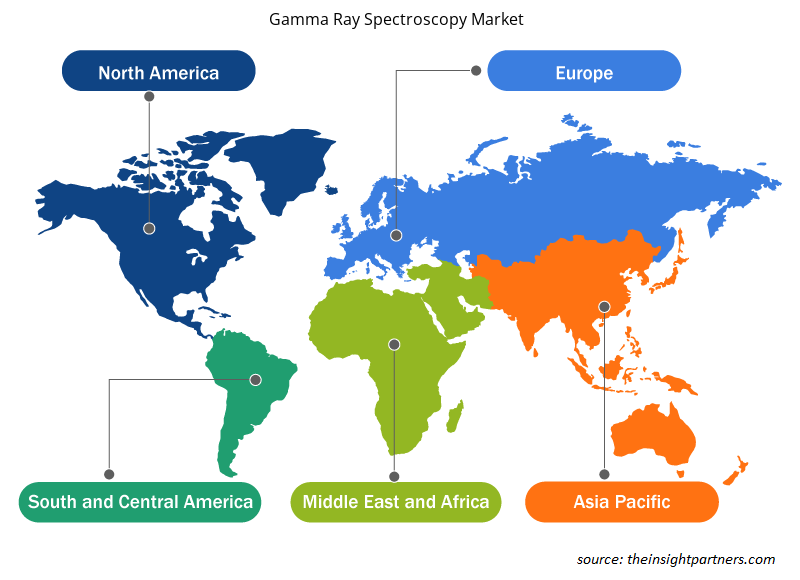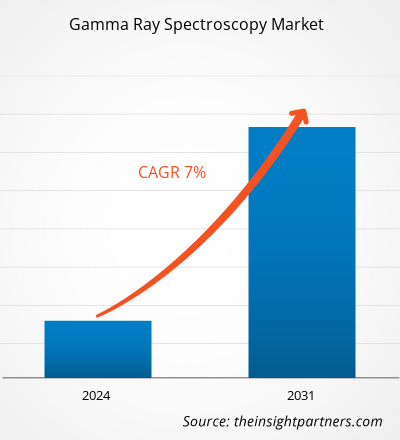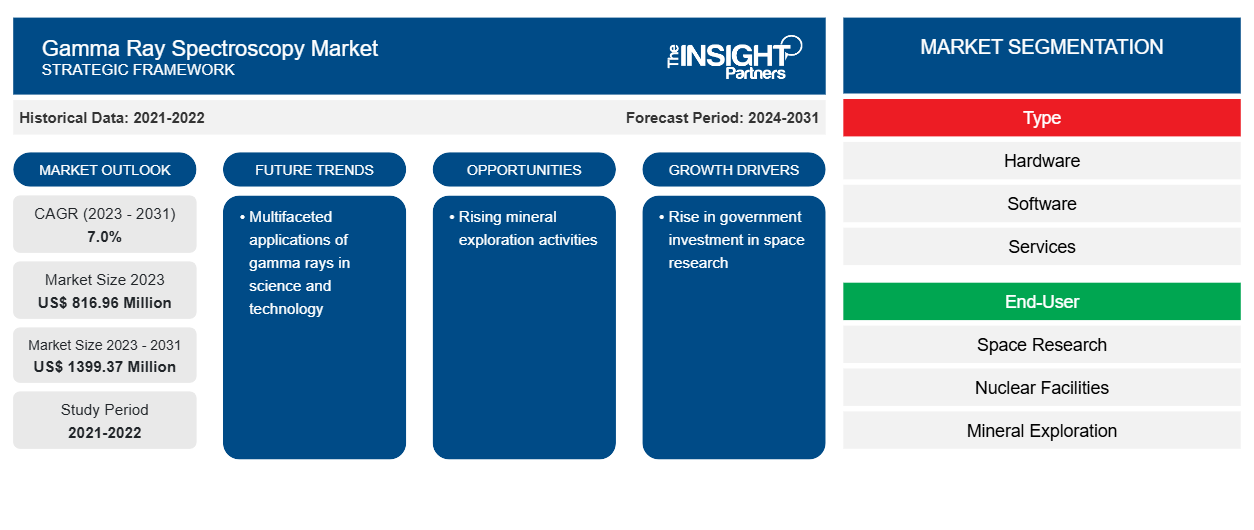Si prevede che la dimensione del mercato della spettroscopia a raggi gamma raggiungerà 1399,37 milioni di dollari entro il 2031, rispetto agli 816,96 milioni di dollari del 2023. Si prevede che il mercato registrerà un CAGR del 7,0% nel periodo 2023-2031. È probabile che l'aumento degli investimenti governativi nella ricerca spaziale e nelle attività di esplorazione mineraria rimanga una tendenza chiave nel mercato.
Analisi di mercato della spettroscopia a raggi gamma
L'uso dello spettrometro a raggi gamma per determinare l'identità e la quantità di emettitori gamma presenti in una sorgente gamma porta alla crescita del mercato. È uno strumento importante per un utile saggio radio ambientale e l'analisi di piccole quantità di materiali radioattivi. Il crescente uso della spettroscopia a raggi gamma per la ricerca spaziale e le attività di esplorazione guida la crescita del mercato. Inoltre, le attività di esplorazione mineraria in tutto il mondo favoriscono ulteriormente la crescita del mercato.
Panoramica del mercato della spettroscopia a raggi gamma
La spettrometria a raggi gamma viene utilizzata per determinare le proprietà qualitative e quantitative dei radionuclidi che emettono radiazioni gamma. La spettrometria gamma presenta numerosi vantaggi perché la preparazione del campione per l'analisi dei radionuclidi è semplice e, nella maggior parte dei casi, non è richiesta una procedura di separazione radiochimica per l'analisi. Inoltre, i dati ottenuti dal sistema di rilevamento sono estremamente adatti per l'elaborazione dei dati da parte di un computer, il che li rende appropriati per la progettazione di sistemi di analisi automatici.
Personalizza questo report in base alle tue esigenze
Riceverai la personalizzazione gratuita di qualsiasi report, comprese parti di questo report, o analisi a livello nazionale, pacchetto dati Excel, oltre a usufruire di grandi offerte e sconti per start-up e università
-
Scopri le principali tendenze di mercato in questo rapporto.Questo campione GRATUITO includerà analisi di dati che spaziano dalle tendenze di mercato alle stime e alle previsioni.
Driver e opportunità di mercato della spettroscopia a raggi gamma
Investimenti nella ricerca spaziale
La spettroscopia a raggi gamma è ampiamente utilizzata nella ricerca spaziale per determinare la composizione elementare delle superfici di pianeti, lune e asteroidi. Ad esempio, lo spettrometro a raggi gamma (GRS) può rilevare i raggi gamma emessi dai nuclei degli atomi sulla superficie di Mercurio quando vengono colpiti dai raggi cosmici. Quando i raggi cosmici colpiscono gli elementi chimici nei terreni e nelle rocce, emettono firme energetiche univocamente identificabili sotto forma di raggi gamma. Questi dati possono aiutare gli scienziati a cercare elementi geologicamente significativi come magnesio , ferro, idrogeno, silicio, ossigeno, sodio, titanio e calcio. Pertanto, per tale ricerca, la domanda di spettroscopia a raggi gamma è in aumento. L'investimento nella ricerca spaziale guida la domanda di spettroscopia a raggi gamma. Ad esempio, la NASA finanzia piccole imprese che le aiutano a ricercare nuove idee e sviluppare soluzioni innovative per l'aeronautica, l'esplorazione umana, la scienza e la tecnologia spaziale.
Aumento delle attività di esplorazione mineraria.
C'è un aumento delle attività di esplorazione mineraria in tutto il mondo, dove aumenta la domanda di spettroscopia a raggi gamma. Ad esempio, la spettroscopia a raggi gamma è ampiamente utilizzata nell'esplorazione dell'uranio perché identifica direttamente la presenza di elementi radioattivi naturali . Per tale esplorazione mineraria, le autorità governative investono ulteriormente, guidando la crescita del mercato. Ad esempio, a luglio 2023, per facilitare l'autosufficienza sul fronte dei minerali critici, il Ministero delle miniere ha annunciato un incentivo finanziario per l'esplorazione, equivalente al 25% del costo del progetto, per agenzie pubbliche e private.
Analisi della segmentazione del rapporto di mercato sulla spettroscopia a raggi gamma
I segmenti chiave che hanno contribuito alla derivazione dell'analisi di mercato della spettroscopia a raggi gamma sono la tipologia e l'utente finale.
- In base al tipo, il mercato della spettroscopia a raggi gamma è suddiviso in hardware, software e servizi. Il segmento hardware ha detenuto la quota di mercato maggiore nel 2023.
- In base all'utente finale, il mercato è segmentato in ricerca spaziale, impianti nucleari ed esplorazione mineraria. Il segmento dell'esplorazione mineraria ha detenuto una quota significativa del mercato nel 2023.
Analisi della quota di mercato della spettroscopia a raggi gamma per area geografica
L'ambito geografico del rapporto di mercato sulla spettroscopia a raggi gamma è suddiviso principalmente in cinque regioni: Nord America, Asia Pacifico, Europa, Medio Oriente e Africa, Sud e Centro America.
L'Europa detiene una quota di mercato globale significativa nel 2023. Secondo la World Nuclear Association, l'energia nucleare della Francia genera circa il 70% dell'elettricità grazie alla politica basata sulla sicurezza energetica approvata nel 2014. Secondo questa politica governativa, il paese mirava a ridurre la quota nucleare della produzione di elettricità al 50% entro il 2025, che è stata posticipata dal 2019 al 2035. Inoltre, a febbraio 2022, il paese ha annunciato il suo piano per costruire 6 nuovi reattori nucleari. Lo sviluppo di reattori nucleari contribuirà ulteriormente al mercato della spettroscopia a raggi gamma in Europa.
Approfondimenti regionali sul mercato della spettroscopia a raggi gamma
Le tendenze regionali e i fattori che influenzano il mercato della spettroscopia a raggi gamma durante il periodo di previsione sono stati ampiamente spiegati dagli analisti di Insight Partners. Questa sezione discute anche i segmenti e la geografia del mercato della spettroscopia a raggi gamma in Nord America, Europa, Asia Pacifico, Medio Oriente e Africa e America meridionale e centrale.

- Ottieni i dati specifici regionali per il mercato della spettroscopia a raggi gamma
Ambito del rapporto di mercato sulla spettroscopia a raggi gamma
| Attributo del report | Dettagli |
|---|---|
| Dimensioni del mercato nel 2023 | 816,96 milioni di dollari USA |
| Dimensioni del mercato entro il 2031 | 1399,37 milioni di dollari USA |
| CAGR globale (2023-2031) | 7,0% |
| Dati storici | 2021-2022 |
| Periodo di previsione | 2024-2031 |
| Segmenti coperti |
Per tipo
|
| Regioni e Paesi coperti |
America del Nord
|
| Leader di mercato e profili aziendali chiave |
|
Densità degli attori del mercato: comprendere il suo impatto sulle dinamiche aziendali
Il mercato della spettroscopia a raggi gamma sta crescendo rapidamente, spinto dalla crescente domanda degli utenti finali dovuta a fattori quali l'evoluzione delle preferenze dei consumatori, i progressi tecnologici e una maggiore consapevolezza dei vantaggi del prodotto. Con l'aumento della domanda, le aziende stanno ampliando le loro offerte, innovando per soddisfare le esigenze dei consumatori e capitalizzando sulle tendenze emergenti, il che alimenta ulteriormente la crescita del mercato.
La densità degli operatori di mercato si riferisce alla distribuzione di aziende o società che operano in un particolare mercato o settore. Indica quanti concorrenti (operatori di mercato) sono presenti in un dato spazio di mercato in relazione alle sue dimensioni o al valore di mercato totale.
Le principali aziende che operano nel mercato della spettroscopia a raggi gamma sono:
- CAEN SpA
- Tecnologie Mirion, Inc.
- AMETEK Inc
- Società per azioni Linde
- Geofisica Sander limitata
- Strumenti NUVlATech
Disclaimer : le aziende elencate sopra non sono classificate secondo un ordine particolare.

- Ottieni una panoramica dei principali attori del mercato della spettroscopia a raggi gamma
Notizie di mercato e sviluppi recenti sulla spettroscopia a raggi gamma
Il mercato della spettroscopia a raggi gamma viene valutato raccogliendo dati qualitativi e quantitativi post-ricerca primaria e secondaria, che includono importanti pubblicazioni aziendali, dati di associazioni e database. Di seguito sono elencati alcuni degli sviluppi nel mercato della spettroscopia a raggi gamma:
- Posizionato a 6,5 piedi (2 metri) di distanza dalla navicella spaziale Psyche della NASA sulla punta di un braccio, lo spettrometro a raggi gamma (GRS) della missione è entrato in funzione nel novembre 2023 per la prima volta dal lancio a metà ottobre. Il GRS è metà dello strumento spettrometro a raggi gamma e neutroni (GRNS) della missione Psyche. I dati sono stati raccolti come parte di una serie di attività altamente orchestrate che sono state attentamente pianificate e provate negli ultimi tre anni. (Fonte: The Johns Hopkins University Applied Physics Laboratory LLC, comunicato stampa, dicembre 2023)
Copertura e risultati del rapporto di mercato sulla spettroscopia a raggi gamma
Il rapporto "Dimensioni e previsioni del mercato della spettroscopia a raggi gamma (2021-2031)" fornisce un'analisi dettagliata del mercato che copre le seguenti aree:
- Dimensioni e previsioni del mercato della spettroscopia a raggi gamma a livello globale, regionale e nazionale per tutti i principali segmenti di mercato coperti dall'ambito
- Tendenze del mercato della spettroscopia a raggi gamma, nonché dinamiche di mercato quali driver, vincoli e opportunità chiave
- Analisi dettagliata delle cinque forze PEST/Porter e SWOT
- Analisi di mercato della spettroscopia a raggi gamma che copre le principali tendenze del mercato, il quadro globale e regionale, i principali attori, le normative e i recenti sviluppi del mercato
- Analisi del panorama industriale e della concorrenza che copre la concentrazione del mercato, l'analisi della mappa di calore, i principali attori e gli sviluppi recenti per il mercato della spettroscopia a raggi gamma
- Profili aziendali dettagliati
- Analisi storica (2 anni), anno base, previsione (7 anni) con CAGR
- Analisi PEST e SWOT
- Valore/volume delle dimensioni del mercato - Globale, Regionale, Nazionale
- Industria e panorama competitivo
- Set di dati Excel
Report recenti
Testimonianze
Motivo dell'acquisto
- Processo decisionale informato
- Comprensione delle dinamiche di mercato
- Analisi competitiva
- Analisi dei clienti
- Previsioni di mercato
- Mitigazione del rischio
- Pianificazione strategica
- Giustificazione degli investimenti
- Identificazione dei mercati emergenti
- Miglioramento delle strategie di marketing
- Aumento dell'efficienza operativa
- Allineamento alle tendenze normative























 Ottieni un campione gratuito per - Mercato della spettroscopia a raggi gamma
Ottieni un campione gratuito per - Mercato della spettroscopia a raggi gamma